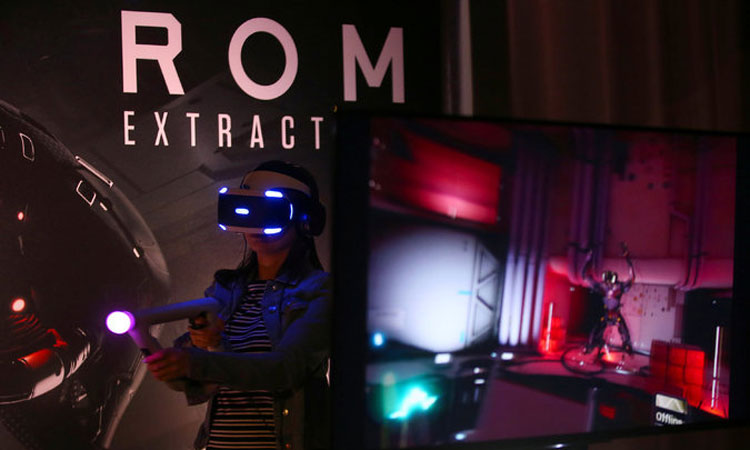It isn’t long now before people will be able to play the popular open-world action game The Elder Scrolls V: Skyrim in virtual reality, with the expected date being the end of the year.
Gamers will also be able to get their hands on virtual-reality versions of the first-person shooter game Doom, the post-apocalyptic game Fallout, and independent titles like Sisters, a horror game that explores virtual reality in an episodic format.
This list of video game titles is a huge moment for virtual reality. Even as the hype over the technology has outrun its actual adoption, the video gaming industry has continued to pour money and resources into embracing virtual reality, cementing its development and advancement — at least in the near term.
“The dream of virtual reality was born in our industry when we created the first virtual worlds,” said Michael D. Gallagher, president and chief executive of the Entertainment Software Association, a trade group for video game companies. “It’s only natural our industry’s passionate and creative innovators, who share that dream, would lead the way in the development of virtual reality.”
So far virtual reality has only left disappointment in many areas, with sales of some of the most capable virtual-reality headsets, which put people into an immersive environment, being somewhat pedestrian.
Various industries have dabbled with virtual reality — and are still only dabbling. Even Mark Zuckerberg, the chief executive of Facebook, who was a huge proponent of virtual reality and bought Oculus VR for more than $2bn several years ago, admitted in January that turning the technology into a new computing platform was tougher than he had expected.
“These things end up being more complex than you think upfront,” Mr. Zuckerberg said at the time. “If anything, we may have to invest even more money to get to the goals we had than we had thought upfront.”
But in gaming, virtual reality is flourishing. Worldwide revenue for the augmented-reality and virtual-reality market is projected to grow to more than $162bn in 2020, from $5.2bn in 2016, driven largely by gaming consoles and mobile virtual-reality headsets and experiences, according to IDC, a research firm.
The appetite of gamers for virtual reality was on display last week at the Electronic Entertainment Expo , or E3, the video game industry’s annual trade show in Los Angeles. Game publishers such as Bethesda and Sony announced that several popular video games would be available as virtual-reality experiences this year, including the Elder Scrolls V: Skyrim, Fallout and Doom.
At E3, independent game developers also showcased half a dozen virtual-reality titles, such as Virtual Virtual Reality, an absurdist black comedy from the studio Tender Claws that plays with ideas of tourism, travel and authority; and SnowVR, a dreamlike game made by two Tehran-born artists who were unable to attend E3 because of travel restrictions.
The appeal of virtual reality in gaming has long been clear. Pete Hines, vice president of public relations and marketing at Bethesda Softworks, which makes the Elder Scrolls and Fallout franchises, said first-person shooter games and open-world role-playing games were best suited to the virtual-reality experience because they provided players with a great sense of immersion.
“You’re not looking at a screen on which something is displayed; all you see is the screen — you’re in it,” Mr. Hines said.
What has changed now is that many of the early games with virtual reality are shifting to a more experimental phase. Some of the first titles with virtual reality “were more like showcases for V.R. technology, but we’re moving past that phase,” said Richard Marks, head of Sony’s PlayStation Magic Lab, part of the company’s research and development group.
Now developers are trying out new technologies and ways to apply virtual reality, like artificial intelligence, voice recognition and ‘co-presence,’ essentially a multiplayer experience in virtual reality that allows two or more players to play together, he said.
One recent example of this is Sony’s multiplayer shooter game Starblood Arena, which combines traditional multiplayer gaming with the immersion of virtual reality. The game lets players match up in an online arena and engage in combat in a range of modes, from a free-for-all death match to team-based play, where players can join forces to defend a particular objective.
Virtual reality still faces hurdles in gaming. The industry is still working out how to deal with the nausea that some people feel after they put on an immersive virtual-reality headset, for example.
“There are lots of fundamental issues V.R. hasn’t worked out, such as nausea or how our body actually moves and reacts,” said Mattie Brice, an associate director at IndieCade, an international festival highlighting the work of innovative independent game developers. “V.R. has to figure out what’s unique about it besides being immersive, a consumer product buzzword for every advancement since games went 3D.”
Other game developers said there was not yet enough demand for virtual reality from consumers to allow more video game studios to focus solely on virtual-reality content.
“What needs to happen is for the early visionaries to stay the course, the investors to continue subsidizing the first wave of content until the economics are in place, and the platforms to continue maturing their hardware to bring in more consumers,” said Ray Davis, chief executive and a founder of Drifter Entertainment, a Seattle start-up that is working on a virtual-reality multiplayer sci-fi shooter game called Gunheart. “All we need right now is a healthy dose of patience.”
Still, the video game industry’s continued effort in pushing virtual reality’s boundaries is leading other industries — particularly other parts of the entertainment business — to take notice.
Baobab Studios, a California-based virtual-reality animation studio, aims to combine elements of animation and video games to create interactive stories. The studio’s coming project, Rainbow Crow, an animated virtual-reality series based on a Native American folk tale and developed in partnership with John Legend, who also stars in it, allows players to interact with the storybooklike environment.
For example, in one scene, players can use virtual-reality controllers to ‘paint’ the surrounding environment, turning it from fall to winter. Waving one’s arms up and down causes it to snow.
“It took many years for gaming to advance, just like it took decades for film to figure out its language of cuts, pans and zooms,” said Maureen Fan, chief executive and a founder of Baobab Studios. “Games are often about being someone else or escaping to another reality. Therefore, V.R. intersects directly with gaming. We are at the very beginning of creating this industry.”




Comments are closed, but trackbacks and pingbacks are open.